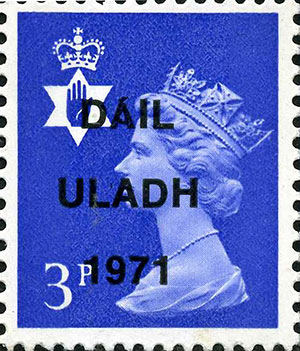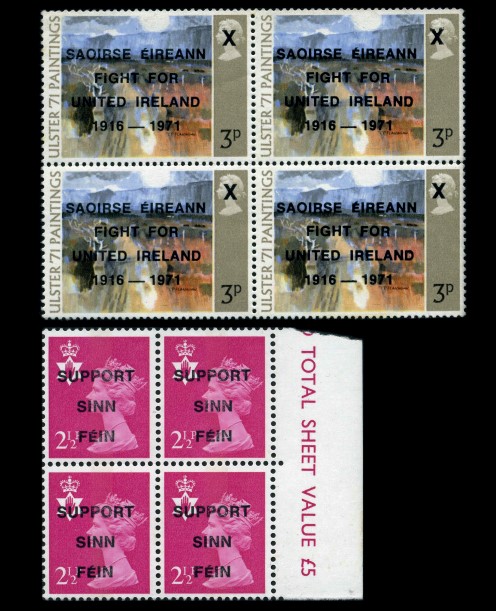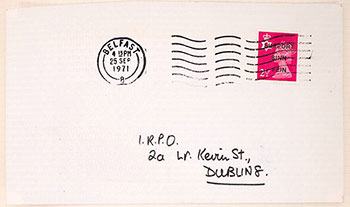The Northern Ireland ‘stamp war’, 1971–2
Published in Features, Issue 5 (September/October 2021), Volume 29By Matin Modarressi
To commemorate the semi-centenary of Northern Ireland, the UK government launched a four-month festival in Belfast’s Botanic Gardens known as ‘Ulster ’71’ and issued a set of postage stamps featuring colourful landscape paintings of Northern Ireland. The government was seeking to convey a message of pride and progress against a backdrop of escalating violence, but in its attempt to influence the public narrative surrounding this anniversary it unwittingly gave Irish republicans the very medium through which to disseminate their views.
‘Republicans launch stamp war—Queen’s head Xed out’
The stamps that were issued had three different designs and denominations. The 3p one, for use on first-class letters, was described by the British Post Office as ‘one of a set of paintings of Irish bog landscapes which inspired “Bogland”, a poem by the Ulster poet Seamus Heaney’. The picturesque design, however, could not distract from the politically motivated timing of the stamp. After the UK stamp was issued in June 1971, it took just three days for Irish republicans to annotate the stamp with an explicitly anti-British message. They took sheets of the UK stamps and printed over the placid image with a freshly added layer of text that read ‘Saoirse Éireann/Fight for United Ireland/1916–1971’. The original stamp was meant to commemorate the 1921 establishment of Northern Ireland as part of the UK, a great loss to Irish nationalists. The new stamp presented an alternative set of dates to celebrate the 55th anniversary of the 1916 Easter Rising, which, though unsuccessful, inspired the later and more successful War of Independence (1919–21). In addition, the queen’s silhouette (which appears on all UK commemorative stamps) was obliterated by a black ‘X’.
That week, over 100 envelopes bearing this stamp but with no return address were mailed from Belfast. One was mailed to the Irish Times in Dublin, which announced it on its front page. One newspaper in London (Irish Post) had this dramatic headline: ‘Republicans launch stamp war—Queen’s head Xed out’. Even the Boston Globe wrote about the stamp, courtesy of its book editor, who happened to be travelling in Ireland.
‘Irish Republican Philatelic Office (IRPO)’
Claiming responsibility was the Irish Republican Philatelic Office (IRPO)—an organisation that shared an address with the Dublin headquarters of Provisional Sinn Féin in Kevin Street. In a press release, the IRPO claimed that the stamp had ‘carried the message of Ireland’s fight for freedom to all parts of the world’. Furthermore, about 50 envelopes bearing this stamp had actually been franked by the British Post Office. The IRPO began to sell these British-franked envelopes for £2 each ‘in an effort to raise funds for the Republican Movement’. In addition, it sold unused copies of the overprinted stamps for 10p each.
Internal memos found in the British Post Office archives reveal that officials were hesitant to postmark the envelopes to avoid legitimising these ‘defaced’ stamps. At the same time, they did not want to surcharge the envelopes for fear that this would create a collector’s item and that the revenue would go to the Republic of Ireland. Instead, they tried to intercept the envelopes and deliver them without a postmark and with a letter simply stating that the stamp was invalid.
That summer, there was a flurry of six letters to the editor of the Irish Times from three different people, arguing over the legitimacy of these stamps. Some argued that they were made legitimate simply by virtue of having been franked and delivered. Passions ran high on the subject. One of the writers who opposed the legitimacy of the overprinted stamp claimed that the spokesman for the IRPO ‘should have learned some philately before designating his a Philatelic Office’. While veiled as a philatelic debate, the core of the matter was clearly one of Irish nationalism versus British loyalism.
‘Support Sinn Féin’ and ‘Dáil Uladh 1971’

Above: A sample of the overprinted ‘DÁIL ULADH 1971’ stamp that appeared in September 1971, referring to a proposed alternative Ulster assembly to replace the unionist-dominated Northern Ireland parliament.
In September the IRPO sent a leaflet to the media and stamp dealers announcing that it had overprinted two more stamps featuring Queen Elizabeth’s face. On one, the words ‘Support Sinn Féin’ were superimposed on the monarch’s profile in bold black letters. The other bore the words ‘Dáil Uladh 1971’, referring to a proposed alternative Ulster assembly to replace the unionist-dominated Northern Ireland parliament. The tone of the leaflet was conspiratorial, saying, for example, that ‘The stamps were overprinted in British Occupied Ireland by printers in the Republican Movement whose names cannot be revealed for security reasons’.
Several newspapers portrayed these stamps as linked to the IRA, with headlines like ‘IRA stamps on sale in Dublin’ (Irish Independent) and ‘British PO carries the IRA “message”’ (Evening Herald). When asked about this connection, an IRPO spokesman told the US-based Éire Philatelic Association the following year that ‘We rely on the cooperation of Sinn Féin and the IRA in overprinting, publicizing, advertising, and distributing these stamps. All officers of the IRPO are either members of Sinn Féin or officers or volunteers in the IRA or both’.
This time around, the IRPO claimed that about 100 envelopes had slipped through the cracks and were postmarked and delivered. It also publicised that the previous edition of postmarked envelopes had sold out. Although it is impossible to verify how many stamps the IRPO sold, a Canadian Globe and Mail reporter who visited the IRPO in November wrote that
‘The phone is ringing constantly and there is a continuous flow of people in and out including a young man bringing in more stamps: “We got $70 from America in one day”.’

Above: Samples (top) of ‘Ulster ’71’ commemorative stamps overprinted with ‘SAOIRSE ÉIREANN FIGHT FOR UNITED IRELAND 1916–1971’ that appeared in June 1971, and (bottom) of stamps overprinted with ‘SUPPORT SINN FÉIN’ that appeared the following September.
Reaction of philatelists
Over in England, enthusiasm for these stamps was not necessarily shared among philatelists. One stamp dealer asked his MP whether parliament could pass an emergency act prohibiting the sale of the stamps. The MP forwarded the letter to the UK minister for posts and communications, who replied that he thought it would be disproportionate, adding: ‘I should hope that we could leave it to the good sense of philatelic traders in this country not to deal in these objectionable stamps’. The Guardian also accused the IRA of running a ‘stamp racket’, suggesting that the stamps deliberately came out around Christmas so that the IRA could take the money of ‘unsuspecting British schoolchildren’.
Because of this increased publicity, in January 1972 the British Post Office made a formal statement and requested that philatelic magazines publish it. The original draft of the statement (found in the postal archives) declared the stamps ‘strictly illegal’, but the British Post Office’s solicitors wanted to avoid an argument over whether overprinting the stamps was technically a criminal offence, and so the final version was more nuanced: ‘Overprinting in this manner is unauthorized by the Post Office and renders the stamps in question invalid for the prepayment of postage’.
‘I gCuimhne Dhoire 30.1.72’

Above: An envelope bearing the overprinted ‘SUPPORT SINN FÉIN’ stamp, franked by the British Post Office and delivered to the ‘IRPO’ (Irish Republican Philatelic Office), an organisation that shared an address with the Dublin headquarters of Provisional Sinn Féin in Kevin Street. Such Post Office-franked envelopes were sold by the IRPO for the premium price of £2.
If the Post Office was trying to make the stamp story go away, their efforts were in vain. In February 1972 an article about the stamps appeared in the New York Times. The following month, the IRPO announced that it had overprinted a fourth stamp, which read ‘I gCuimhne Dhoire 30.1.72’ (‘In memory of Derry’). This overprint was meant to further tarnish the Crown by referring to Bloody Sunday, an event decried by the international human rights community and later described in 2010 by British Prime Minister David Cameron as ‘unjustified and unjustifiable’. In a press release, the IRPO reported that of 300 envelopes that were mailed from Belfast and Derry about 100 had been delivered postmarked.
The press release also gave a more detailed explanation of the entire stamp operation, namely that the use of these stamps had embarrassed the British government and that the empty threats of the police claim to have the authority to arrest people for possessing these stamps had been exposed. Additionally, the press release stated that, ‘by causing the British Post Office to use their sorting staff to attempt to intercept and surcharge all mail with these stamps affixed, one of the primary British organizations in the Occupied Area of Ireland has been disrupted’. In short, Irish republicans had succeeded in their goal of disrupting ‘business as usual’ for what they viewed as the occupying British government.
Conclusion
Ultimately, the question regarding the legitimacy of these postage stamps is moot. While philatelists may debate whether the overprinted stamps were technically ‘postage stamps’, the message they carried and the publicity they garnered renders their genuineness, or lack thereof, irrelevant. As one of the people who wrote to the editor of the Irish Times explained, ‘If the surcharge of 7p helps in any way to undo the occupation of my country, I will have additional pleasure from my collection’. The IRPO did not intend to create a postage stamp for the mundane purpose of sending mail. Rather, it sought to infiltrate the routine operations of the British government and to force that government to conspire in its own humiliation. It transformed an everyday object into an emblem of defiance and a tool of resistance.
Matin Modarressi is a philatelist based in New York.
FURTHER READING
G. McIntosh, ‘Stormont’s ill-timed jubilee: the Ulster ’71 exhibition’, New Hibernia Review/Iris Éireannach Nua 11 (2) (2007).
















